Flexible Power Point Tracking Using a Neural Network for Power Reserve Control in a Grid-Connected PV System
Abstract
1. Introduction
Contribution
- (i)
- (ii)
- To operate the PV array on the left side of MPP as against the right-sided operation in [14,18]. The advantages and disadvantages of the operational characteristics on both sides of MPP are explained in Section 3.1.2.
2. Literature Review
3. Control Technique
3.1. Mathematical Formulation
3.1.1. Power Reserve for Frequency Regulation
3.1.2. Point of Operation of PV Array
3.2. Neural Network-Based FPPT
- The specified number of repetitions/epochs have been completed.
- The time limit has been reached.
- The performance is minimized to the set goal
- The performance gradient falls below the minimum of min_grad.
- The value of mu exceeds its specified maximum value of mu_max.
- The performance of the validation process increases to more than the maximum number of max_fail times.
4. Simulation Results
Discussions
5. Conclusions
Author Contributions
Funding
Data Availability Statement
Conflicts of Interest
References
- Tielens, P.; Van Hertem, D. The relevance of inertia in power systems. Renew. Sustain. Energy Rev. 2016, 55, 999–1009. [Google Scholar] [CrossRef]
- Hadjikypris, M.; Efthymiou, V.; Georghiou, G.E. Enhanced Frequency Response of Inverter Dominated Low Inertia Power Systems. In Proceedings of the 2019 1st International Conference on Energy Transition in the Mediterranean Area (Synergy Med), Cagliari, Italy, 28–30 May 2019; pp. 1–6. [Google Scholar] [CrossRef]
- Tamrakar, U.; Hansen, T.M.; Tonkoski, R.; Copp, D.A. Model Predictive Frequency Control of Low Inertia Microgrids. In Proceedings of the 2019 IEEE 28th International Symposium on Industrial Electronics (ISIE), Vancouver, BC, Canada, 12–14 June 2019; pp. 2111–2116. [Google Scholar] [CrossRef]
- Tamrakar, U.; Shrestha, D.; Maharjan, M.; Bhattarai, B.P.; Hansen, T.M.; Tonkoski, R. Virtual inertia: Current trends and future directions. Appl. Sci. 2017, 7, 654. [Google Scholar] [CrossRef]
- You, S. Photovoltaic (PV) Virtual Inertia and Fast Frequency Regulation in High PV Power Grids. arXiv 2020, arXiv:2010.11340. [Google Scholar]
- Rajan, R.; Fernandez, F.M.; Yang, Y. Primary frequency control techniques for large-scale PV-integrated power systems: A review. Renew. Sustain. Energy Rev. 2021, 144, 110998. [Google Scholar] [CrossRef]
- Nazih, A.; Osheba, D.S.M.; Mansour, A.S. Virtual inertia impact on the performance of photovoltaic system. In Proceedings of the 2019 IEEE Conference on Power Electronics and Renewable Energy (CPERE), Aswan, Egypt, 23–25 October 2019; pp. 7–11. [Google Scholar] [CrossRef]
- Rahmann, C.; Castillo, A. Fast frequency response capability of photovoltaic power plants: The necessity of new grid requirements and definitions. Energies 2014, 7, 6306–6322. [Google Scholar] [CrossRef]
- Liu, Y.; Zhu, L.; Zhan, L.; Gracia, J.R.; King, T.J.; Liu, Y. Active power control of solar PV generation for large interconnection frequency regulation and oscillation damping. Int. J. Energy Res. 2015, 40, 353–361. [Google Scholar] [CrossRef]
- Kakimoto, N.; Takayama, S.; Satoh, H.; Nakamura, K. Power modulation of photovoltaic generator for frequency control of power system. IEEE Trans. Energy Convers. 2009, 24, 943–949. [Google Scholar] [CrossRef]
- Akram, U.; Nadarajah, M.; Shah, R.; Milano, F. A review on rapid responsive energy storage technologies for frequency regulation in modern power systems. Renew. Sustain. Energy Rev. 2019, 120, 109626. [Google Scholar] [CrossRef]
- Zarina, P.P.; Mishra, S.; Sekhar, P.C. Deriving inertial response from a non-inertial PV system for frequency regulation. In Proceedings of the 2012 IEEE International Conference on Power Electronics, Drives and Energy Systems (PEDES), Bengaluru, India, 16–19 December 2012; pp. 1–5. [Google Scholar] [CrossRef]
- Rajan, R.; Fernandez, F.M. Power control strategy of photovoltaic plants for frequency regulation in a hybrid power system. Int. J. Electr. Power Energy Syst. 2019, 110, 171–183. [Google Scholar] [CrossRef]
- Zarina, P.; Mishra, S.; Sekhar, P. Exploring frequency control capability of a PV system in a hybrid PV-rotating machine-without storage system. Int. J. Electr. Power Energy Syst. 2014, 60, 258–267. [Google Scholar] [CrossRef]
- Gomez, J.M. Frequency and Inertia Response Effects, Capabilities, and Possibilities in Renewable Energy Sources. Recent Adv. Comput. Sci. Commun. 2022, 15, 1115–1139. [Google Scholar] [CrossRef]
- Gomez, J.M.; Shanmugam, P.K. Frequency response study in microgrid system with distributed generation having reduced inertia. In Proceedings of the 2020 IEEE International Women in Engineering (WIE) Conference on Electrical and Computer Engineering (WIECON-ECE), Bhubaneswar, India, 26–27 December 2020; pp. 183–190. [Google Scholar] [CrossRef]
- Gomez, J.M.; Shanmugam, P.K. Back-to- B ack Converter-Controlled Operation of Doubly F ed Induction Generator Wind Turbine and Solar Photovoltaic System. Innov. Power Adv. Comput. Technol. 2021, 2021, 1–6. [Google Scholar]
- Zhong, C.; Zhou, Y.; Yan, G. Power reserve control with real-time iterative estimation for PV system participation in frequency regulation. Int. J. Electr. Power Energy Syst. 2020, 124, 106367. [Google Scholar] [CrossRef]
- Sangwongwanich, A.; Yang, Y.; Blaabjerg, F.; Sera, D. Delta Power Control Strategy for Multistring Grid-Connected PV Inverters. IEEE Trans. Ind. Appl. 2017, 53, 3862–3870. [Google Scholar] [CrossRef]
- Hoke, A.; Muljadi, E.; Maksimovic, D. Real-time photovoltaic plant maximum power point estimation for use in grid frequency stabilization. In Proceedings of the 2015 IEEE 16th workshop on Control and Modeling for Power Electronics (COMPEL), Vancouver, BC, Canada, 12–15 July 2015; pp. 1–7. [Google Scholar] [CrossRef]
- Batzelis, E.I.; Kampitsis, G.E.; Papathanassiou, S.A. Power Reserves Control for PV Systems With Real-Time MPP Estimation via Curve Fitting. IEEE Trans. Sustain. Energy 2017, 8, 1269–1280. [Google Scholar] [CrossRef]
- Hiyama, T.; Kitabayashi, K. Neural network based estimation of maximum power generation from PV module using environmental information. IEEE Trans. Energy Convers. 1997, 12, 241–247. [Google Scholar] [CrossRef]
- Taherbaneh, M.; Faez, K. Maximum power point estimation for photovoltaic systems using neural networks. In Proceedings of the 2007 IEEE International Conference on Control and Automation, Guangzhou, China, 30 May–1 June 2007; pp. 1614–1619. [Google Scholar] [CrossRef]
- Baskarad, T.; Kuzle, I.; Holjevac, N. Photovoltaic System Power Reserve Determination Using Parabolic Approximation of Frequency Response. IEEE Trans. Smart Grid 2021, 12, 3175–3184. [Google Scholar] [CrossRef]
- Mishra, S.; Zarina, P.P.; Sekhar, P.C. A novel controller for frequency regulation in a hybrid system with high PV penetration. In Proceedings of the 2013 IEEE Power & Energy Society General Meeting, Vancouver, BC, Canada, 21–25 July 2013; pp. 1–5. [Google Scholar]
- Kim, D.; Park, J.-W.; Lee, S. A study on the power reserve of distributed generators based on power sensitivity analysis in a large-scale power system. Electronics 2021, 10, 769. [Google Scholar] [CrossRef]
- Tarraso, A.; Candela, J.I.; Rocabert, J.; Rodriguez, P. Synchronous power control for PV solar inverters with power reserve capability. In Proceedings of the IECON 2017-43rd Annual Conference of the IEEE Industrial Electronics Society, Beijing, China, 29 October–1 November 2017; pp. 2712–2717. [Google Scholar] [CrossRef]
- Tavakkoli, M.; Adabi, J.; Zabihi, S.; Godina, R.; Pouresmaeil, E. Reserve Allocation of Photovoltaic Systems to Improve Frequency Stability in Hybrid Power Systems. Energies 2018, 11, 2583. [Google Scholar] [CrossRef]
- Hoke, A.; Maksimovic, D. Active power control of photovoltaic power systems. In Proceedings of the 2013 1st IEEE Conference on Technologies for Sustainability (SusTech), Portland, OR, USA, 1–2 August 2013; pp. 70–77. [Google Scholar] [CrossRef]
- Sera, D.; Mathe, L.; Kerekes, T.; Spataru, S.V.; Teodorescu, R. On the perturb-and-observe and incremental conductance mppt methods for PV systems. IEEE J. Photovolt. 2013, 3, 1070–1078. [Google Scholar] [CrossRef]
- Wellawatta, T.R.; Seo, Y.-T.; Lee, H.-H.; Choi, S.-J. A regulated incremental conductance (r-INC) MPPT algorithm for photovoltaic system. In Proceedings of the 2017 IEEE Energy Conversion Congress and Exposition (ECCE), Cincinnati, OH, USA, 1–5 October 2017; pp. 2305–2309. [Google Scholar] [CrossRef]
- Sangwongwanich, A.; Yang, Y.; Blaabjerg, F.; Wang, H. Benchmarking of Constant Power Generation Strategies for Single-Phase Grid-Connected Photovoltaic Systems. IEEE Trans. Ind. Appl. 2017, 54, 447–457. [Google Scholar] [CrossRef]
- Yang, Y.; Wang, H.; Blaabjerg, F.; Kerekes, T. A hybrid power control concept for PV inverters with reduced thermal loading. IEEE Trans. Power Electron. 2014, 29, 6271–6275. [Google Scholar] [CrossRef]
- Rosa, C.; Vinikov, D.; Romero-Cadaval, E.; Pires, V.; Martins, J. Low-power home PV systems with MPPT and PC control modes. In Proceedings of the 2013 International Conference-Workshop Compatibility And Power Electronics, Ljubljana, Slovenia, 5–7 June 2013; pp. 58–62. [Google Scholar] [CrossRef]
- Urtasun, A.; Sanchis, P.; Marroyo, L. Limiting the power generated by a photovoltaic system. In Proceedings of the 2013 10th International Multi-Conference on Systems, Signals & Devices (SSD), Hammamet, Tunisia, 18–21 March 2013; pp. 1–6. [Google Scholar] [CrossRef]
- Tang, C.-Y.; Chen, Y.-T.; Chen, Y.-M. PV Power System with Multi-Mode Operation and Low-Voltage Ride-Through Capability. IEEE Trans. Ind. Electron. 2015, 62, 7524–7533. [Google Scholar] [CrossRef]
- Sangwongwanich, A.; Yang, Y.; Blaabjerg, F. Sensorless reserved power control strategy for two-stage grid-connected Photovoltaic systems. In Proceedings of the 2016 IEEE 7th international symposium on power electronics for distributed generation systems (PEDG), Vancouver, BC, Canada, 27–30 June 2016; pp. 1–8. [Google Scholar] [CrossRef]
- Bao, G.; Tan, H.; Ding, K.; Ma, M.; Wang, N. A novel photovoltaic virtual synchronous generator control technology without energy storage systems. Energies 2019, 12, 2240. [Google Scholar] [CrossRef]
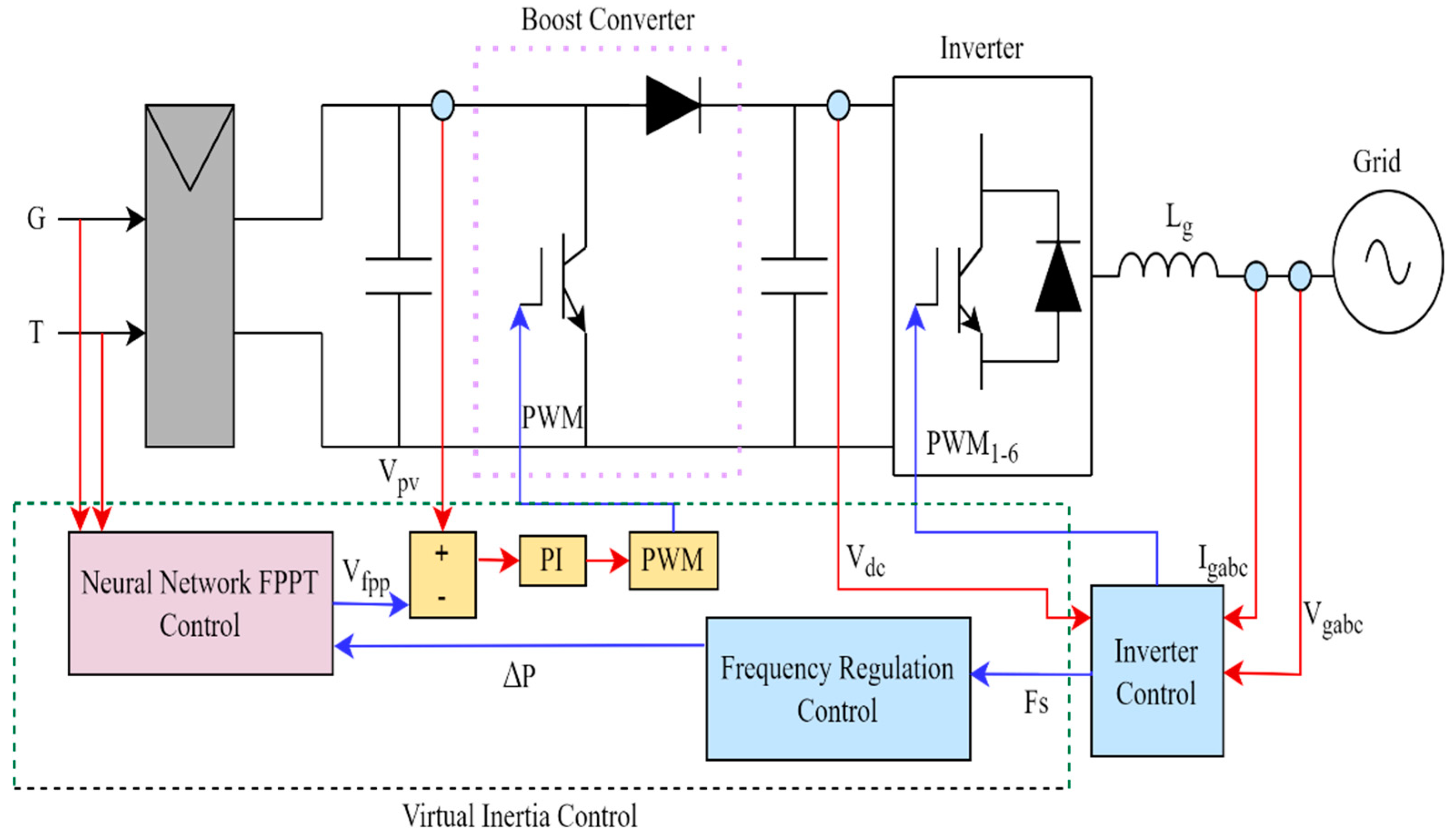

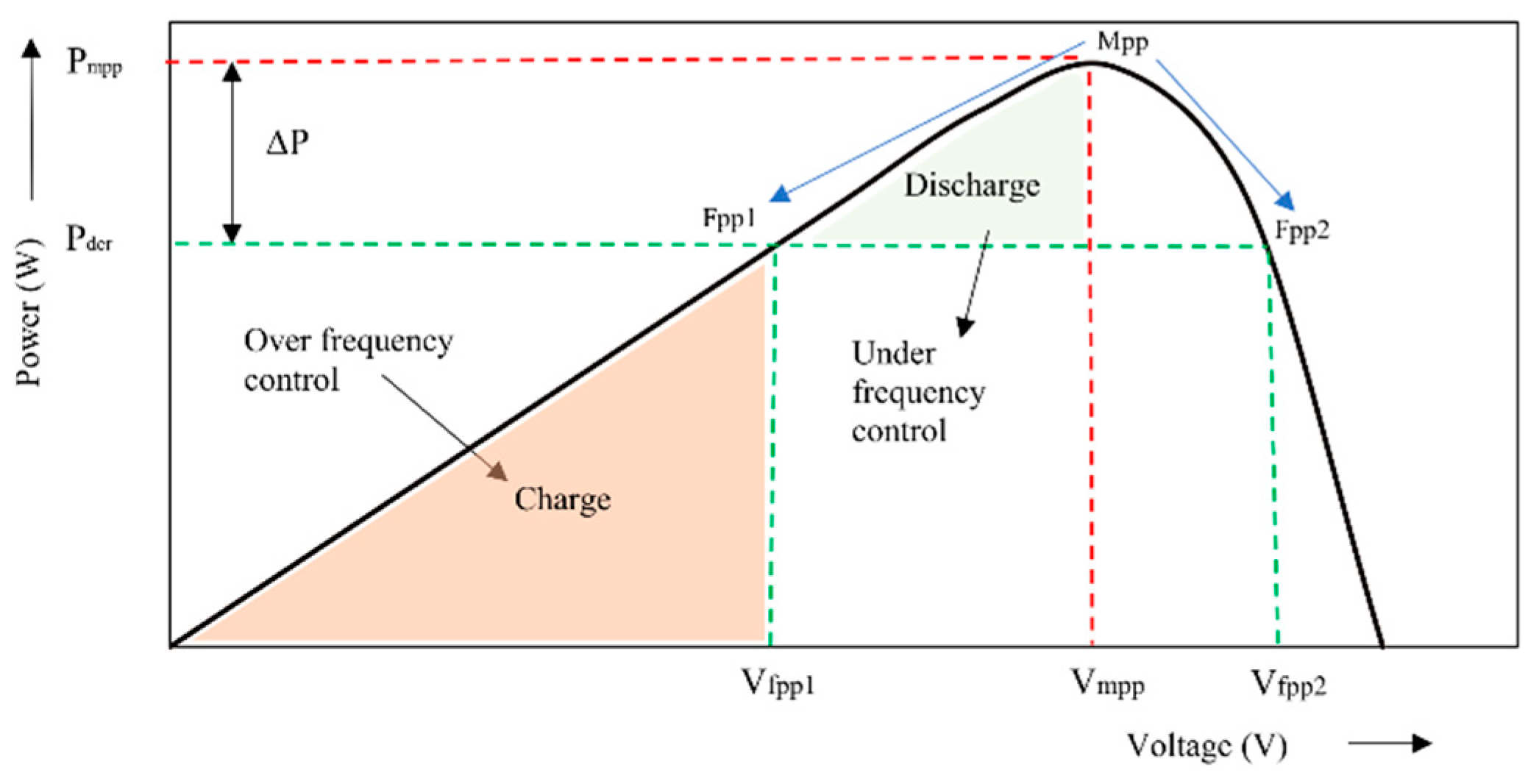
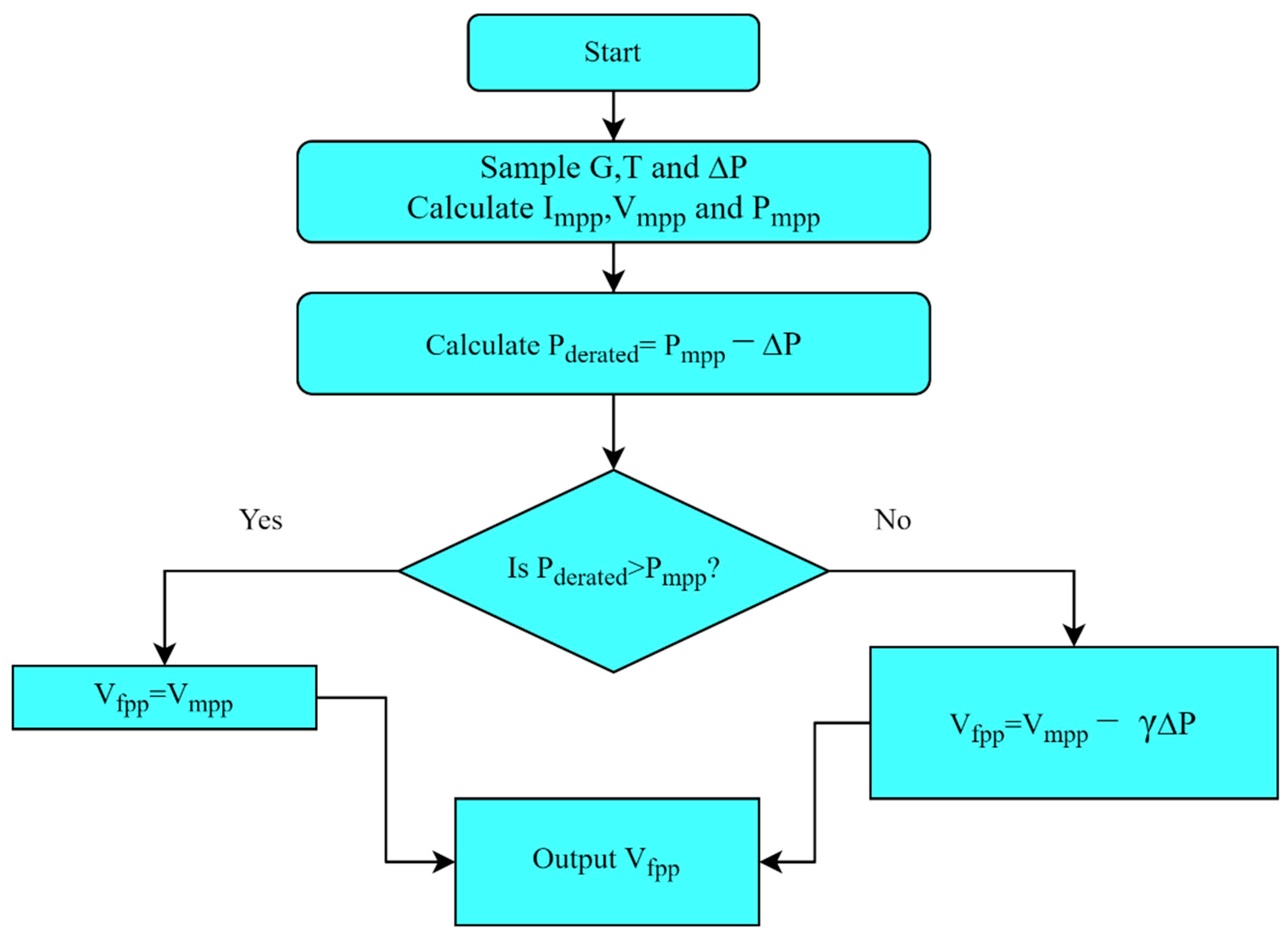


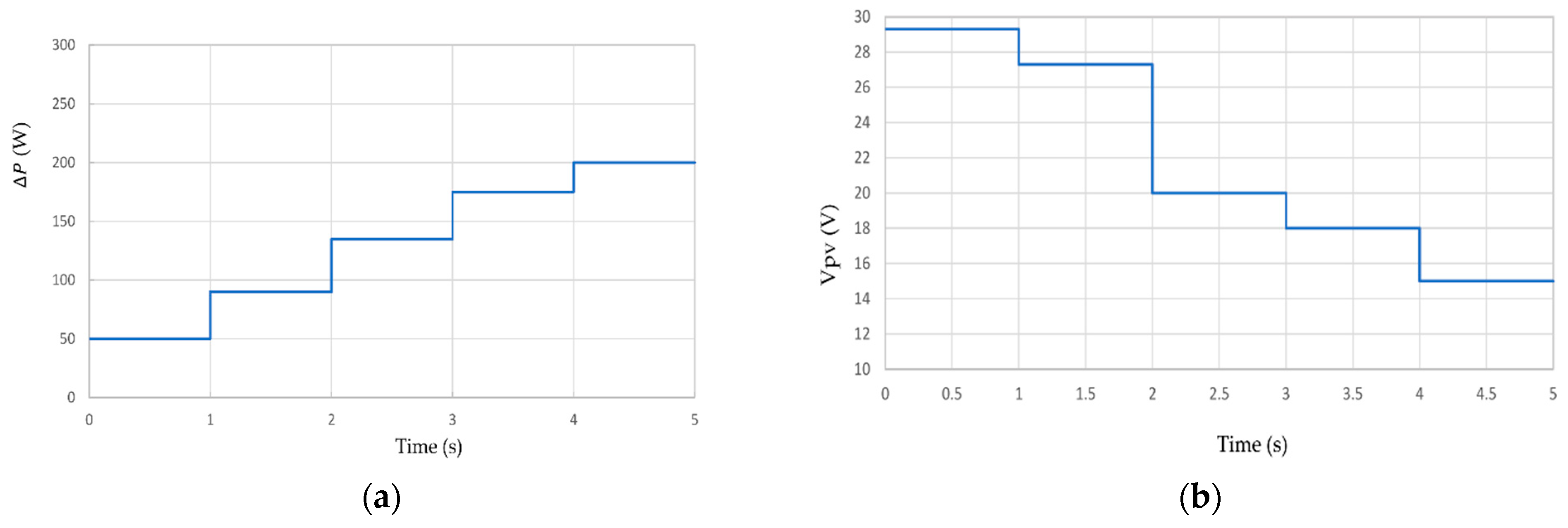



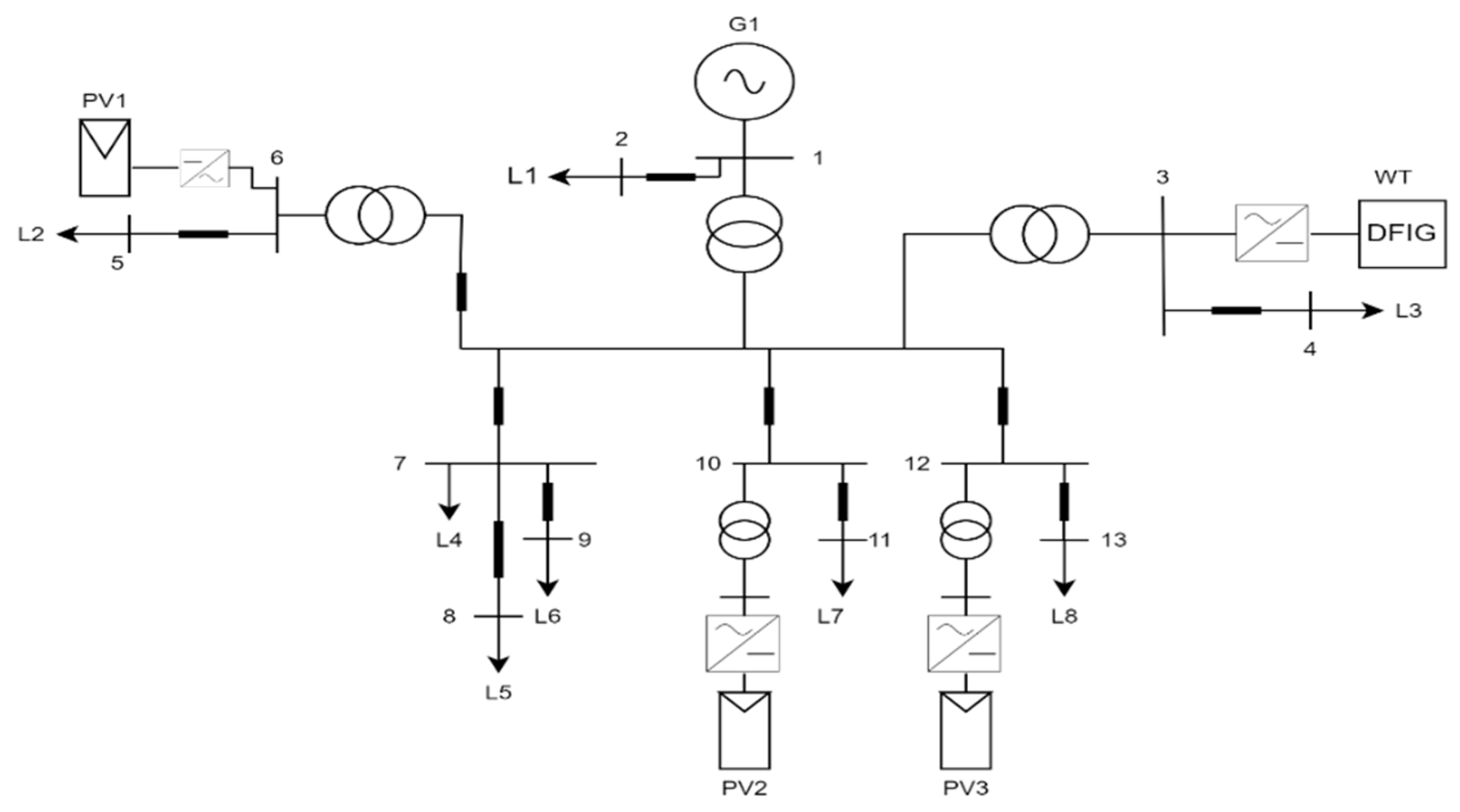

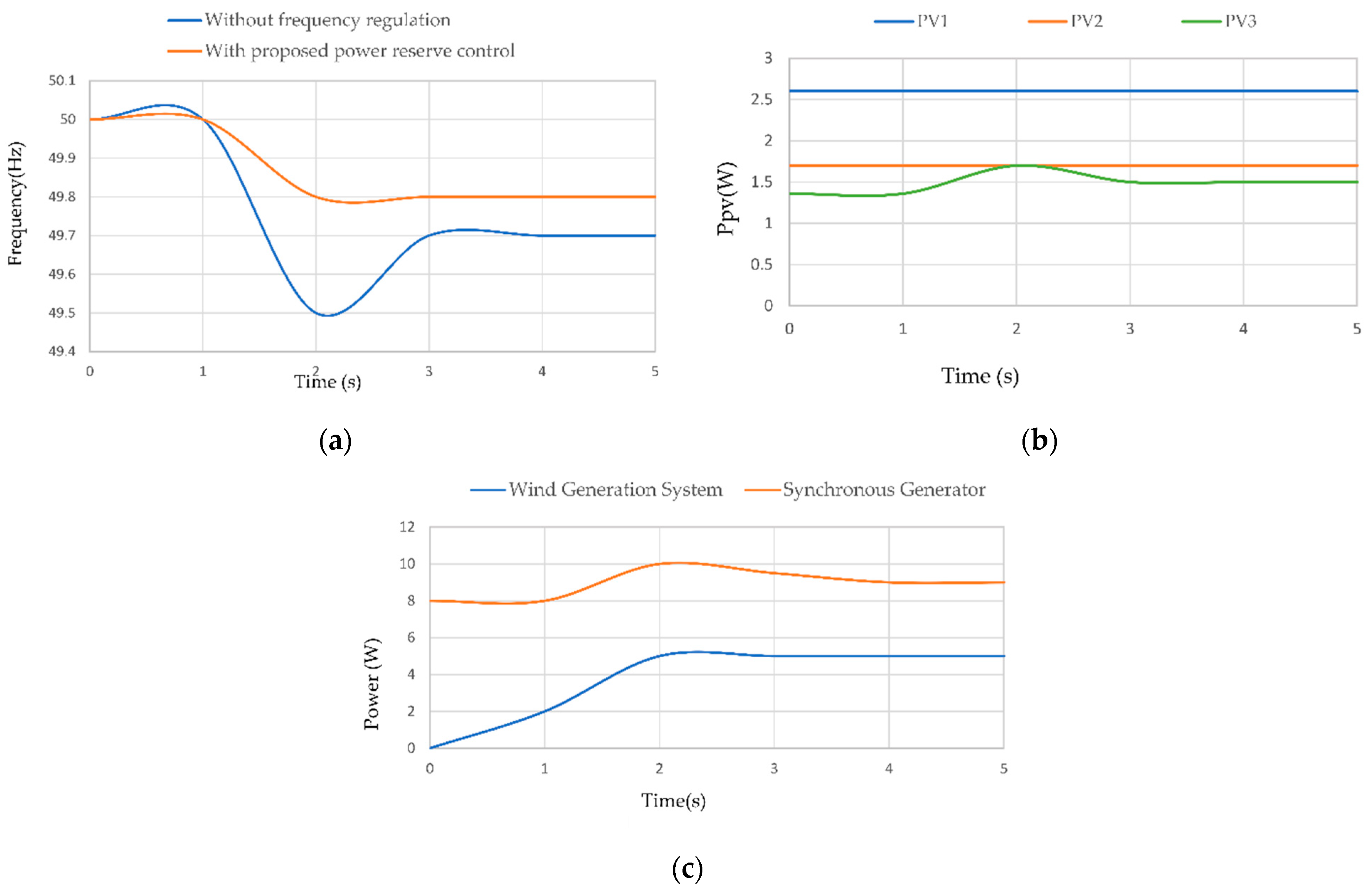
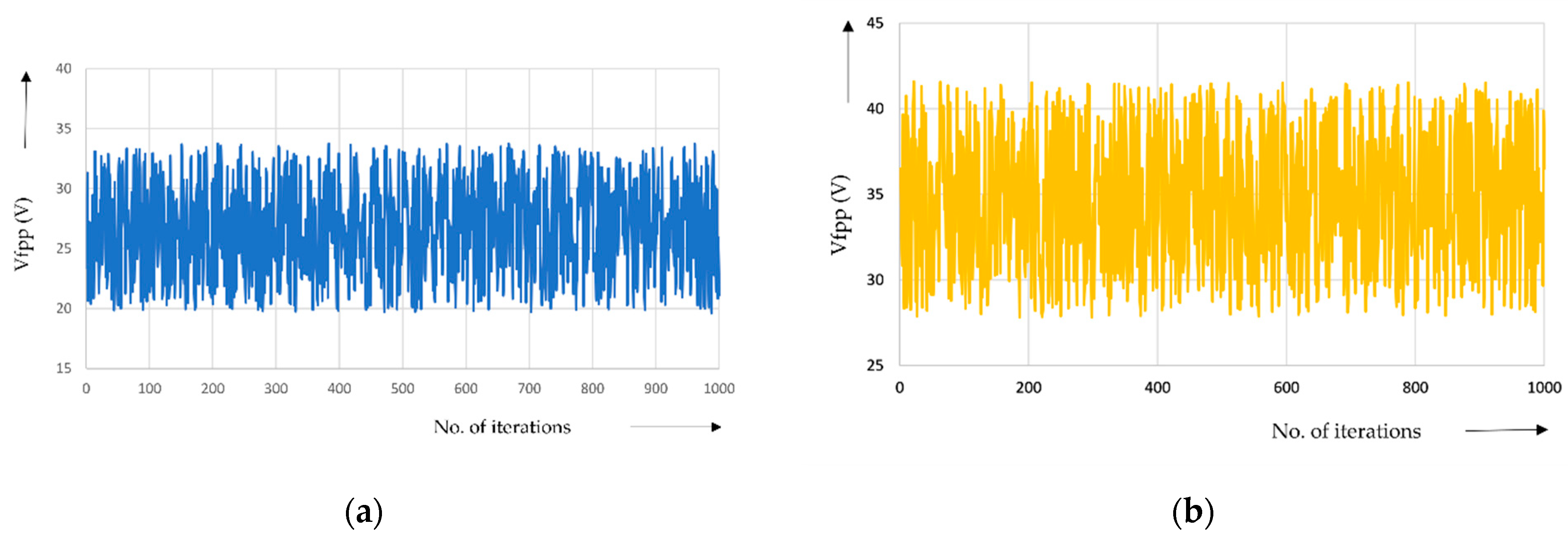
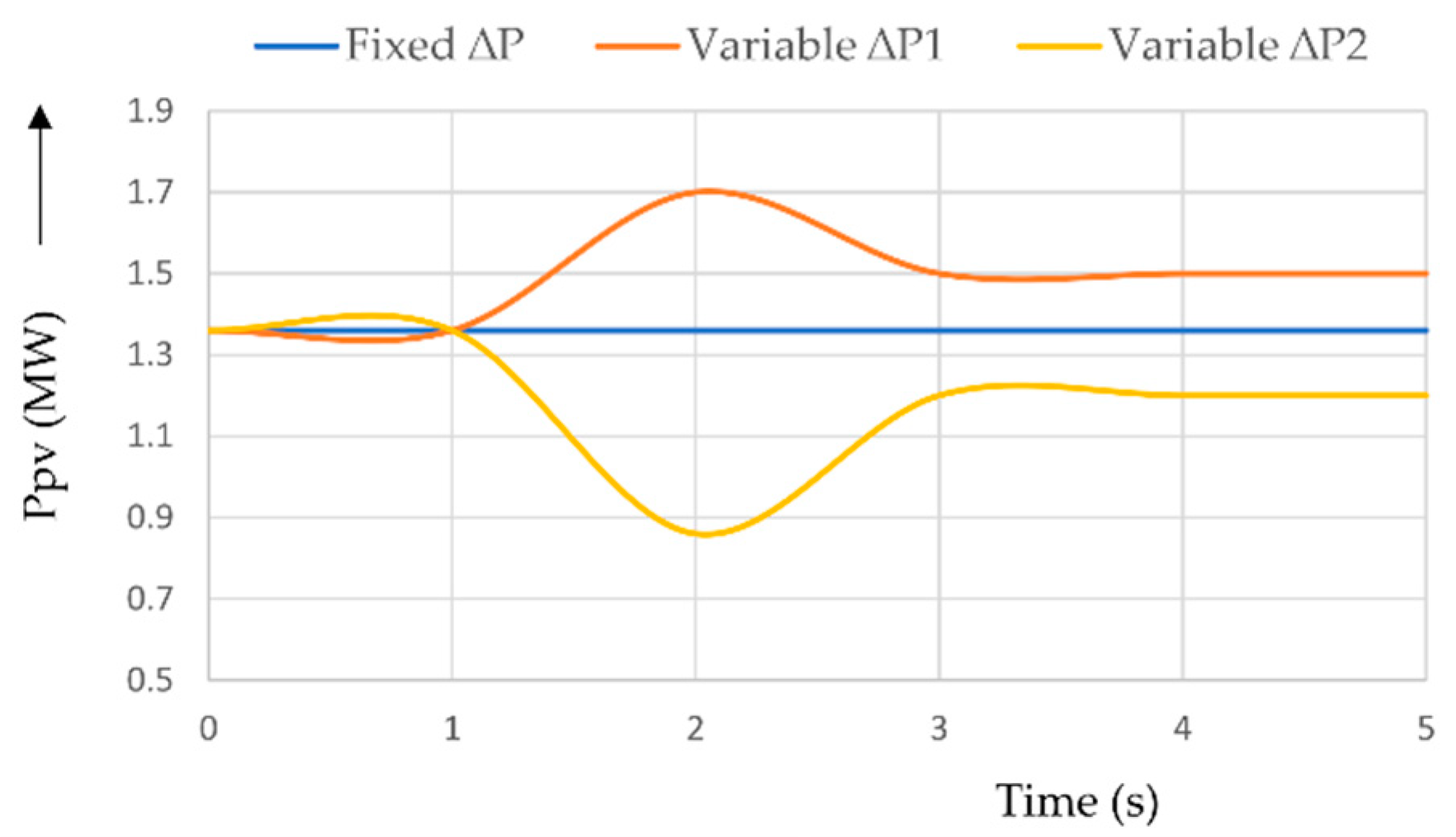
| Parameter | Value |
|---|---|
| Open circuit voltage under STC, VOC,STC | 37.3 V |
| Short circuit current under STC, ISC,STC | 8.6 A |
| Parallel resistance, Rsh | 313.0553 ohms |
| Series resistance, Rs | 0.3981 ohms |
| Open circuit voltage thermal correlation co-efficient, β | 0.86998 |
| Short circuit current thermal correlation co-efficient, α | −0.6901 |
| Diode ideal factor, A | 0.98119 |
| Ref No. | Power Reserve Control | Advantages | Limitations |
|---|---|---|---|
| Proposed Control |
|
| The method requires temperature and irradiance sensors. |
| [18] |
| It does not require irradiance and temperature sensors. |
|
| [19] |
| It does not require individual irradiance and temperature sensors. | It does not change the power reserve following frequency deviations. |
Publisher’s Note: MDPI stays neutral with regard to jurisdictional claims in published maps and institutional affiliations. |
© 2022 by the authors. Licensee MDPI, Basel, Switzerland. This article is an open access article distributed under the terms and conditions of the Creative Commons Attribution (CC BY) license (https://creativecommons.org/licenses/by/4.0/).
Share and Cite
Gomez, J.M.; Shanmugam, P.K. Flexible Power Point Tracking Using a Neural Network for Power Reserve Control in a Grid-Connected PV System. Energies 2022, 15, 8234. https://doi.org/10.3390/en15218234
Gomez JM, Shanmugam PK. Flexible Power Point Tracking Using a Neural Network for Power Reserve Control in a Grid-Connected PV System. Energies. 2022; 15(21):8234. https://doi.org/10.3390/en15218234
Chicago/Turabian StyleGomez, Jishu Mary, and Prabhakar Karthikeyan Shanmugam. 2022. "Flexible Power Point Tracking Using a Neural Network for Power Reserve Control in a Grid-Connected PV System" Energies 15, no. 21: 8234. https://doi.org/10.3390/en15218234
APA StyleGomez, J. M., & Shanmugam, P. K. (2022). Flexible Power Point Tracking Using a Neural Network for Power Reserve Control in a Grid-Connected PV System. Energies, 15(21), 8234. https://doi.org/10.3390/en15218234





